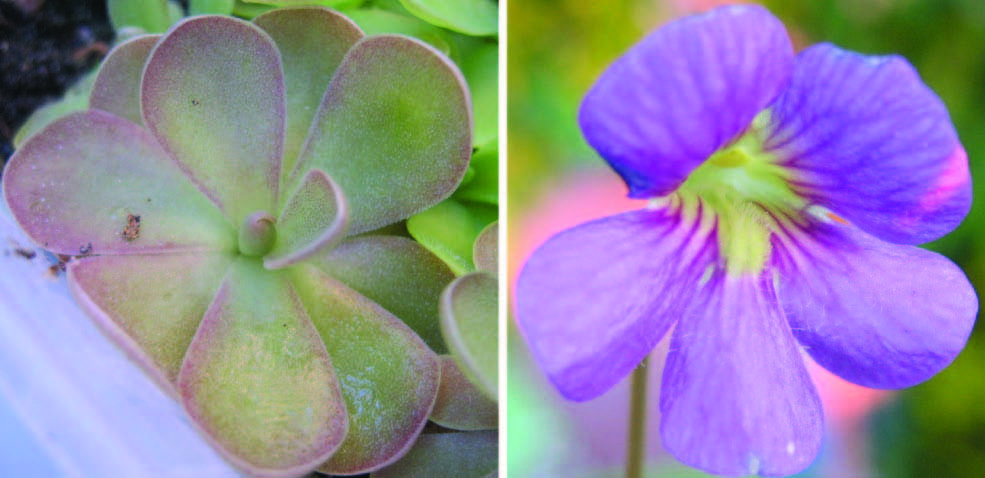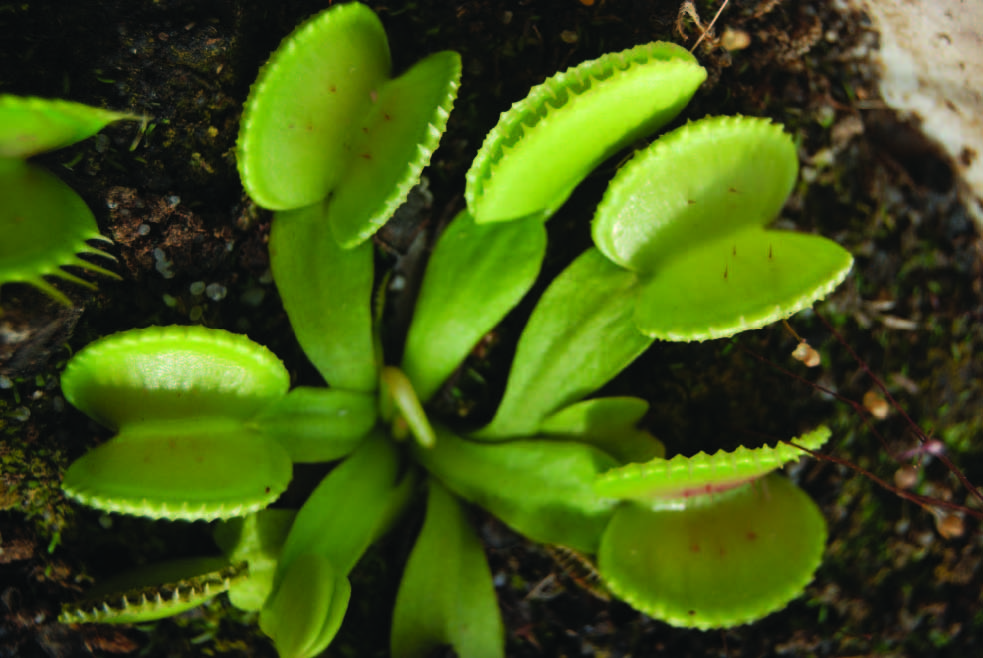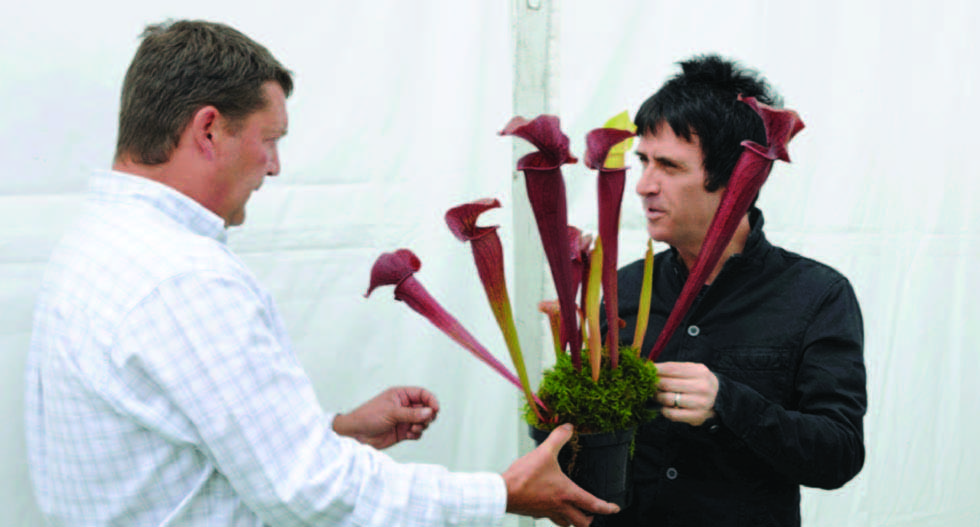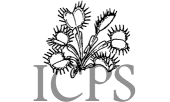|
Carnivorous Plant Newsletter
Volume 39, Number 4, December 2010, pages 117 - 120
New Cultivars
Pinguicula ‘Johanna’ (Pinguicula agnata × debbertiana)
Dionaea muscipula ‘Coquillage’
Dionaea muscipula ‘Alien’
Sarracenia ‘Johnny Marr’
Pinguicula ‘Johanna’ (Pinguicula agnata × debbertiana)
Submitted: 21 August 2010
The hybrid between Pinguicula agnata and Pinguicula debbertiana was created in 2009. The seeds produced several different-looking plants that belong to the Pinguicula Hairy Tongue Group. One of these clones is Pinguicula ‘Johanna’.
The plant itself is heterophyllous, which in summer has about 25 round leaves (up to 4 cm) that overlap partially, while in winter has about 40 leaves with a length of 2-3 cm. The amount of light on a south facing windowsill is enough to color the plant a nice orange-red (see Figure 1). With poor lighting the leaves are green like those of the parents. Summer rosette is about 9 cm in diameter; winter rosette is smaller about 4-5 cm.
The flower has two upper and three lower petals (which do not overlap) and has a total size of about 2 cm (see Figure 1). Flowering is between March and May, during which 3-6 flowers are typically produced. The color is a light purple, very close to P. debbertiana and gets darker in the middle of the flower. The throat instead is nearly white and shows a venation like P. debbertiana. Venation is strong in the middle of the flower and becomes hard to see on the outer petal. Like P. agnata, the hybrid flower has a strong pubescence, especially on the lower petals and where P. debbertiana has it´s typical “yellow brush”. The “brush” itself is weakly developed with a white-yellow color.
—Christian Weinberger • Charentonerstrasse 36 • 33142 Büren • Germany • chweinberger@ gmx.de

Figure 1: Pinguicula ‘Johanna’ plant (left) and flower (right).
Dionaea muscipula ‘Coquillage’
Submitted: 11 August 2010
Dionaea muscipula ‘Coquillage’ was found at the Carniflora open day on May 17, 2008. The traps are well-shaped with widely spaced short teeth and very thick lips (see Figure 2). Traps are usually smaller than 3 cm. The round shape of the traps when closed resembles the shape of a shell. Coquillage means shell in French. Vegetative propagation is necessary to maintain the unique features
of this plant.
—Guillaume Bily • 56520 Guidel • France • gbily2003@yahoo.fr

Figure 2: Dionaea ‘Coquillage’.
ERRATUM: The name of Dr. Jang printed in the cultivar description for Dionaea ‘Korean Melody Shark’ published in Carniv. Pl. Newslett. 39: 44–45 was in error and should be corrected to Dr. Gi-Won Jang, not Dr. Jang Gi-Won.
Dionaea muscipula ‘Alien’
Submitted: 11 August 2010
Dionaea muscipula ‘Alien’ was found at the Carniflora open day on May 17, 2008. The most spectacular feature of this new cultivar is the extremely arched shape of all of the traps (see Figure 3), which are 4 to 5 cm on mature plants. They made me think of the head of an alien from Ridley Scott’s well-known 1979 movie “Alien” (see Figure 4). Dionaea muscipula ‘Alien’also produces strange teeth that are a little shorter than typical Dionaea and have small wings all along the tooth (see Figure 4). Mature traps are also fused at the distal end and base lobes of traps overlap (see Figure 5). Traps do not close well because the lobes of the traps are very heavy, reminding me of a Heliamphora pitcher, and when you try to close it with your fingers it often breaks. Each trap produces many tiny trigger hairs (see Figure 6). Vegetative propagation is necessary to maintain the unique features of this plant.
—Guillaume Bily • 56520 Guidel • France • gbily2003@yahoo.fr
| Figure 3: Dionaea ‘Alien’ plant. |
Figure 4: Dionaea ‘Alien’ teeth. |
| Figure 5: Dionaea ‘Alien’ petiole |
Figure 6: Dionaea ‘Alien’ tiny trigger hairs. |
Sarracenia ‘Johnny Marr’
Submitted: 11 August 2010
Sarracenia ‘Johnny Marr’ is a 1999 hybrid (S. flava var. cuprea × S. purpurea subsp. venosa) × S.
flava var. cuprea. It has strong upright pitchers about 60 cm tall, a large open mouth 5-7 cm across, and
an overhanging wavy lid about 12 cm across (see Figure 7). The top two thirds of spring pitchers are a
stunning bright copper colour and really stand out in the collection. Later in the season, from the end of
June, the pitchers turn a dark burgundy purple all over and the sparse veining is almost black. Flowers are
around 10 cm across with pale pink petals. The plant first flowered in 2003 and the bright copper pitcher
colour has proved to be stable. The plant was named at the 2010 RHS Flower Show at Tatton Park near
Manchester on the 21st of July for the guitarist Johnny Marr (see Figure 8). Propagation is by division only.
—Matthew Soper • Hampshire Carnivorous Plants • Yamayla • Allington Lane • West End
• Southampton so30 3HQ • UK • sales@hantsflytrap.com

Figure 7: Sarracenia ‘Johnny Marr’ spring pitchers (left) and fall pitchers (right).

Figure 8: Matthew Soper (left) introduces Johnny Marr to Sarracenia ‘Johnnie Marr’.
|

